 The last 18 months have seen a growing crescendo of excitement in the content and mobile phone worlds about the possibilities of delivering TV to mobile phone. The ideas been around a lot longer than that, but it’s the smell of money that has heightened senses.
The last 18 months have seen a growing crescendo of excitement in the content and mobile phone worlds about the possibilities of delivering TV to mobile phone. The ideas been around a lot longer than that, but it’s the smell of money that has heightened senses.
Virgin Mobile have been keen to show the pace in this area and BT Livetime).
The handsets are now in pre-production and are getting into the hands of a few people.
James Cridland, Head of New Media Strategy at Virgin Radio has had a pre-production Virgin Mobile Lobster 770TV in his hands for a while and has written up a review of it, complete with the four TV services and 49 radio stations.
Built by HTC, its guts are an Orange SPV C600 but the protrusion on its right hand side holds the DAB chippery. James reports that the headphones are better than SPV600, which the 770TV is based on. They also act as the aerial for the DAB receiver.
James goes into a lot more detail about the handset, but let’s get down to how it performs as a TV.
The content
The four TV channels he had were BBC One London, Channel 4 Shortcuts, E4, and ITV-1 (only available in London). It sounds like the programming on the commercial channels hits a few interruptions due to ‘rights.’
BBC One London is in full and free. E4 and ITV-1 generally shows a simulcast of the main channels, but at some times of the day you get a notice that the current programme is unavailable for ‘rights reasons’ – which, at the time of writing, includes all of E4’s daytime music programming, all advertising, all of GMTV, and quite a few other programmes too: it’s unusual to be able to get all four channels in full, in my experience. Channel 4 Shortcuts shows short clips of Channel 4 shows.
Using it
Starting to watch TV couldn’t be easier, just hitting the TV button, which brings up the TV Guide, which he describes as a fairly comprehensive EPG (electronic programme guide), interestingly updated over-the-air on DAB.
The quality of the service doesn’t sound amazing currently.
Clicking on a channel name opens a screen with a larger logo and a Windows Media ‘buffering’ sign, which disappears fairly quickly to be replaced with a passable picture. The framerate appears quite low – probably no more than 10 frames a second – and the picture quality does break up in fast movement; this isn’t picture quality to write home about, but conversely it is pretty good at coping with variable signal quality – on occasion, you can sometimes lose the picture but keep the sound. Watching live television in a moving taxi is an interesting experience, but works very well.
Radio service
James is significantly more impressed with this Lobster as a DAB radio, finding “the reception quality is rather better than I’ve experienced with an FM radio,” indeed, “it’s no exaggeration to say that this is the best hand-held DAB Digital Radio that I’ve ever had.”
Given his role at Virgin Radio, he’s a man who knows a thing or two about radio too.
Conclusion
Despite liking the other functions of the Lobster, it appears James won’t be chucking out his TV anytime soon, finding the current channels available not good enough.
I can’t see too many people sitting down for half an hour of Coronation Street on this thing; and it would seem to me that the television offering needs changing – to offer more grazing-friendly programming. Sky News or BBC News 24 would be a great addition. The absence of GMTV on the phone shows what disarray the commercial broadcasters are in – why cede peak commuting time to the BBC alone?
Clearly early days in this fledgling area.
Full details are over on James’ blog
Photo credit: James Cridland
 LG has announced the soon-come launch of its new LG-BH620T, a DVB-T phone letting soap-addicts thrill to Coronation Street while they’re out on the move.
LG has announced the soon-come launch of its new LG-BH620T, a DVB-T phone letting soap-addicts thrill to Coronation Street while they’re out on the move.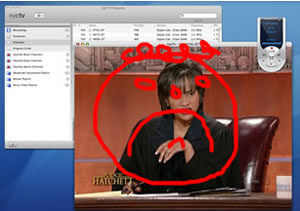 The new software works with all the Miglia decoders and offers similar functionality to EyeTV.
The new software works with all the Miglia decoders and offers similar functionality to EyeTV. The software also works directly with iTunes so stored video will appear on any connected AppleTVs.
The software also works directly with iTunes so stored video will appear on any connected AppleTVs. Her guidance to them is to settle on DVB-H (Digital Video Broadcasting for Handhelds), a European led development of the DVB-T (Television) standard that is throughout large areas of Europe.
Her guidance to them is to settle on DVB-H (Digital Video Broadcasting for Handhelds), a European led development of the DVB-T (Television) standard that is throughout large areas of Europe.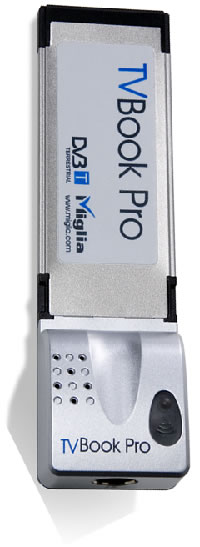 Until then, Miglia has been bundling Elgato’s TVEye software with their digital TV DVB-T/Freeview/TNT tuners.
Until then, Miglia has been bundling Elgato’s TVEye software with their digital TV DVB-T/Freeview/TNT tuners.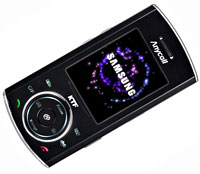 Fresh out of Samsung’s hyperactive phone production line in Korea is the new Anycall SPH-B5800 DMB phone.
Fresh out of Samsung’s hyperactive phone production line in Korea is the new Anycall SPH-B5800 DMB phone.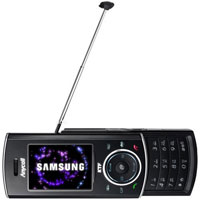 For music fans, there’s a built-in MP3 player with a microSD (TransFlash) port offering expansion options.
For music fans, there’s a built-in MP3 player with a microSD (TransFlash) port offering expansion options.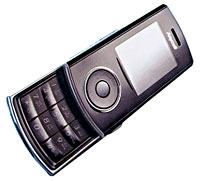 Sadly, there’s no news of a UK release, with the phone currently only available on the KTF network in Korea.
Sadly, there’s no news of a UK release, with the phone currently only available on the KTF network in Korea.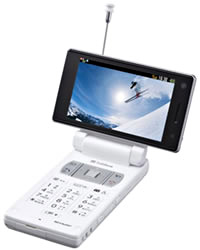 Like a hungry child with its drooling face depositing dribble all over the cake shop window, we’re only able to gaze at the sleek lines of Sharp’s swanky new 911SH TV phone from afar as the Japanese giant has announced that it’s for their home market only.
Like a hungry child with its drooling face depositing dribble all over the cake shop window, we’re only able to gaze at the sleek lines of Sharp’s swanky new 911SH TV phone from afar as the Japanese giant has announced that it’s for their home market only.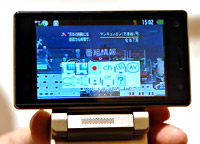 Slapping in a 1 GB card would deliver a mighty 4 hours of recording, although we’re not sure how long the battery would fare when playing back videos.
Slapping in a 1 GB card would deliver a mighty 4 hours of recording, although we’re not sure how long the battery would fare when playing back videos. The last 18 months have seen a growing crescendo of excitement in the content and mobile phone worlds about the possibilities of delivering TV to mobile phone. The ideas been around a lot longer than that, but it’s the smell of money that has heightened senses.
The last 18 months have seen a growing crescendo of excitement in the content and mobile phone worlds about the possibilities of delivering TV to mobile phone. The ideas been around a lot longer than that, but it’s the smell of money that has heightened senses. In an ideal world, waiting near the top of the new OFCOM boss Ed Richards’ in-tray, there should be a folder marked ‘Sky Monopoly’ and on it a brightly coloured post-it with the words anti competitive clearly inscribed.
In an ideal world, waiting near the top of the new OFCOM boss Ed Richards’ in-tray, there should be a folder marked ‘Sky Monopoly’ and on it a brightly coloured post-it with the words anti competitive clearly inscribed. The area where Sky has decided not to use DVB is for its Conditional Access encryption.
The area where Sky has decided not to use DVB is for its Conditional Access encryption. If that TV service then wants to charge the subscribers to their service they have to use that special version of Videoguard CA.
If that TV service then wants to charge the subscribers to their service they have to use that special version of Videoguard CA.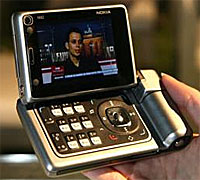 Will you be one of the near-half billion (446m to be exact) people that IMS Research estimate will be watching TV on their cellular handsets around the globe by 2011?
Will you be one of the near-half billion (446m to be exact) people that IMS Research estimate will be watching TV on their cellular handsets around the globe by 2011?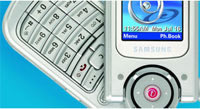 IMS Research
IMS Research Nokia has announced a partnership with TeliaSonera Sweden to trial a complete DVB-H system, using Nokia’s Nordic know-how, their Mobile Broadcast System 3.0 and Nokia N92 mobile TV devices.
Nokia has announced a partnership with TeliaSonera Sweden to trial a complete DVB-H system, using Nokia’s Nordic know-how, their Mobile Broadcast System 3.0 and Nokia N92 mobile TV devices. “Nokia is very pleased to be working so closely with TeliaSonera Sweden in this new area of DVB-H based mobile TV. We believe strongly in the capability of this technology as well as in the mobile TV service, and we are looking forward to verify the full potential of mobile TV together with TeliaSonera Sweden,” purred Jan Lindgren, Vice President, Networks, Nokia.
“Nokia is very pleased to be working so closely with TeliaSonera Sweden in this new area of DVB-H based mobile TV. We believe strongly in the capability of this technology as well as in the mobile TV service, and we are looking forward to verify the full potential of mobile TV together with TeliaSonera Sweden,” purred Jan Lindgren, Vice President, Networks, Nokia.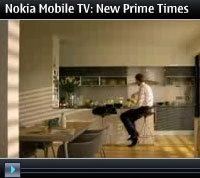 About the technology
About the technology